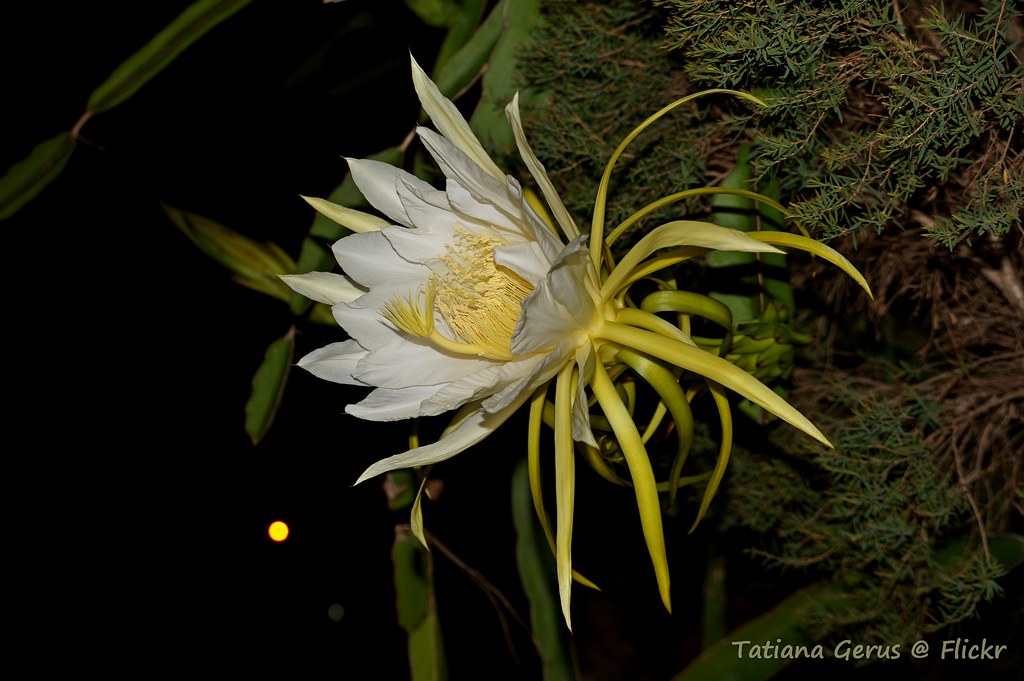
Finding and Cultivating the Elusive Queen of the Night Succulent

The Queen of the Night succulent, also known as Epiphyllum oxypetalum, is a rare and enchanting plant that has captured the attention of succulent enthusiasts around the world. With its strikingly beautiful flowers that bloom only at night, this succulent has a mysterious allure that makes it highly sought after. However, finding and cultivating the Queen of the Night can be a challenge, as it requires specific care and conditions to thrive.
We will delve into the world of the Queen of the Night succulent and explore the techniques and tips for successfully finding and cultivating this elusive plant. We will discuss the origins and characteristics of this unique succulent, as well as the ideal growing conditions and care requirements. Additionally, we will provide step-by-step instructions on how to propagate and propagate this succulent, ensuring that you can enjoy its breathtaking blooms in your own garden. Whether you are a seasoned succulent enthusiast or a beginner looking to add a touch of magic to your plant collection, this article will guide you in your quest to find and cultivate the Queen of the Night succulent.
- Choose a well-draining soil mix for your Queen of the Night succulent
- Place your succulent in a bright, indirect light location
- Water your Queen of the Night sparingly, allowing the soil to dry out between waterings
- Provide proper ventilation to prevent rot or fungal diseases
- Fertilize your succulent with a balanced fertilizer during the growing season
- Prune any dead or damaged leaves to promote healthy growth
- Repot your Queen of the Night succulent every 2-3 years to refresh the soil
- Protect your succulent from extreme temperatures and frost
- Propagate new plants by taking stem or leaf cuttings
- Monitor your succulent for pests and treat them promptly
- Frequently Asked Questions
Choose a well-draining soil mix for your Queen of the Night succulent
When it comes to cultivating the Queen of the Night succulent, one of the most important factors to consider is the type of soil mix you choose. This unique succulent requires a well-draining soil mix that mimics its natural habitat.
Avoid using regular potting soil, as it tends to retain too much moisture, which can lead to root rot and other issues. Instead, opt for a gritty, well-draining soil mix that allows excess water to flow freely.
One great option is a cactus and succulent soil mix, readily available at most garden centers. These mixes are specifically formulated to provide the perfect balance of moisture retention and drainage for succulents like the Queen of the Night.
Alternatively, you can create your own soil mix by combining equal parts of perlite, coarse sand, and well-aged compost. This blend will ensure excellent drainage while providing some organic matter for the succulent to thrive.
 Identifying the Succulent: What Type Is It?
Identifying the Succulent: What Type Is It?Important tip: Whatever soil mix you choose, make sure it is completely dry before watering your Queen of the Night succulent. These plants are drought-tolerant and prefer to dry out between waterings.
Place your succulent in a bright, indirect light location
When it comes to caring for the Queen of the Night succulent, one of the most important factors to consider is its exposure to light. This unique plant thrives in bright, indirect light conditions. Placing it near a window that receives filtered sunlight or in a well-lit room can provide the perfect environment for its growth.
Tip: Avoid placing your Queen of the Night succulent in direct sunlight as it can scorch its leaves and cause damage to the plant.
Water your Queen of the Night sparingly, allowing the soil to dry out between waterings
When it comes to caring for your Queen of the Night succulent, one of the most important considerations is its watering needs. This unique plant, also known as the Epiphyllum oxypetalum, is native to the rainforests of Central and South America, where it has adapted to survive in low-water environments.
To ensure the health and longevity of your Queen of the Night, it's essential to water it sparingly. Overwatering can lead to root rot and other issues that can harm the plant. Instead, allow the soil to dry out between waterings.
But how do you know when it's time to water your Queen of the Night succulent? One way to determine this is by checking the moisture level of the soil. Stick your finger about an inch into the soil, and if it feels dry, it's time to water. However, if the soil still feels moist, it's best to hold off on watering for a few more days.
 Decoding Succulents' Red Edges: A Comprehensive Analysis
Decoding Succulents' Red Edges: A Comprehensive AnalysisWhen watering your Queen of the Night, it's important to do so thoroughly but gently. Use a watering can or a watering hose with a gentle spray attachment to evenly distribute the water. Avoid drenching the leaves or flowers, as this can increase the risk of fungal diseases.
Remember, the Queen of the Night succulent is a desert plant that is adapted to survive in arid conditions. It has the ability to store water in its fleshy leaves and stems, allowing it to withstand periods of drought. By mimicking these conditions and providing just enough water, you can help your Queen of the Night thrive.
Provide proper ventilation to prevent rot or fungal diseases
One of the crucial factors in successfully growing the Queen of the Night succulent is providing proper ventilation. Adequate airflow around the plant helps prevent the occurrence of rot or fungal diseases, which can be detrimental to its health. Here are some key points to consider in ensuring optimal ventilation for your Queen of the Night succulent:
- Choose a well-draining soil: Start by using a well-draining soil mixture specifically formulated for succulents. This type of soil allows excess moisture to drain away quickly, reducing the risk of root rot.
- Use a porous container: Opt for a container made of porous material like terracotta or clay. These materials allow air to circulate through the soil, preventing water from stagnating and causing rot.
- Position the plant in a well-ventilated area: Place your Queen of the Night succulent in a location that receives adequate airflow. Avoid placing it in a closed or poorly ventilated space to minimize the chances of fungal diseases taking hold.
- Provide sufficient spacing: When planting multiple Queen of the Night succulents, ensure there is enough space between each plant. This allows air to circulate freely and reduces the risk of diseases spreading from one plant to another.
- Avoid overwatering: Overwatering is one of the leading causes of rot in succulents. Only water your Queen of the Night when the soil is completely dry, and be sure to drain any excess water from the container.
By following these ventilation guidelines, you can create an environment that promotes the overall health and well-being of your Queen of the Night succulent. Remember, proper airflow is crucial in preventing the onset of rot or fungal diseases, ensuring that your succulent thrives and remains a captivating addition to your plant collection.
Fertilize your succulent with a balanced fertilizer during the growing season
One of the key factors in successfully cultivating the Queen of the Night succulent is providing it with the right nutrients. To ensure healthy growth and vibrant blooms, it is essential to fertilize your succulent with a balanced fertilizer during the growing season.
When choosing a fertilizer, opt for a well-balanced formula that contains equal amounts of nitrogen (N), phosphorus (P), and potassium (K). This balanced ratio will provide your succulent with the necessary nutrients for robust growth and blooming.
 Can You Identify These Gorgeous Succulents?
Can You Identify These Gorgeous Succulents?It's important to note that the Queen of the Night succulent is a slow-growing plant, so it doesn't require frequent fertilization. Aim to fertilize your succulent only once every four to six weeks during the active growing season, which typically spans spring and summer.
Here are some tips for fertilizing your Queen of the Night succulent:
- Choose a liquid or water-soluble fertilizer: Liquid or water-soluble fertilizers are ideal for succulents as they can be easily absorbed by the roots.
- Dilute the fertilizer: Follow the instructions on the fertilizer package to dilute it to the recommended strength. Avoid using a concentrated solution as it may burn the roots of your succulent.
- Apply the fertilizer sparingly: Succulents have a low nutrient requirement, so it's crucial not to over-fertilize. Apply the diluted fertilizer to the soil around the base of the plant, ensuring that it doesn't come into contact with the leaves or stem.
- Water after fertilizing: After applying the fertilizer, give your succulent a thorough watering to help distribute the nutrients evenly throughout the soil.
Remember, while fertilizing is essential for the Queen of the Night succulent, it's equally important to strike a balance. Over-fertilizing can lead to excessive growth and weak stems, making the plant more prone to disease and pests. Always follow the recommended dosage and frequency mentioned on the fertilizer packaging.
By providing your Queen of the Night succulent with the right nutrients at the right time, you'll be rewarded with vigorous growth and breathtaking blooms. So, don't forget to give your succulent a little boost during the growing season!
Prune any dead or damaged leaves to promote healthy growth
When it comes to the Queen of the Night succulent, proper pruning is essential for maintaining its health and encouraging new growth. Regularly inspect your plant for any dead or damaged leaves, as these can negatively impact its overall vitality.
Using a pair of clean and sharp gardening shears, carefully remove any dead or yellowing leaves. Make sure to cut as close to the base of the leaf as possible, taking care not to damage the surrounding healthy foliage. Additionally, if you notice any damaged or diseased leaves, it's important to remove them promptly to prevent the spread of infection.
Pruning dead or damaged leaves not only improves the aesthetic appeal of your Queen of the Night succulent but also allows the plant to redirect its energy towards healthy growth. By eliminating these non-functional leaves, you create more space and resources for the plant to focus on producing new foliage and blooms.
 Ultimate Guide: Identifying Succulents and Getting the Help You Need
Ultimate Guide: Identifying Succulents and Getting the Help You NeedRemember, it's crucial to use clean and sterile tools when pruning your succulent. This helps prevent the introduction of harmful bacteria or pathogens that could further compromise the plant's health. Consider sterilizing your shears with rubbing alcohol before and after each use to ensure the highest level of cleanliness.
Regular pruning not only maintains the overall health of your Queen of the Night succulent but also helps prevent the accumulation of dead leaves and debris that can attract pests or lead to fungal infections. By keeping your plant tidy and well-maintained, you create an optimal environment for its growth and longevity.
Repot your Queen of the Night succulent every 2-3 years to refresh the soil
Repotting your Queen of the Night succulent every 2-3 years is essential to ensure its optimal growth and health. By refreshing the soil, you provide this elusive succulent with the necessary nutrients and space to thrive.
When repotting your Queen of the Night succulent, follow these steps to ensure a successful transition:
Gather the necessary materials:
- A new pot that is slightly larger than the current one
- Well-draining soil mix suitable for succulents
- Gloves to protect your hands from thorns or prickles
- A small trowel or spoon for scooping out the old soil
- Newspaper or a dropcloth to minimize mess
Prepare the succulent for repotting:
Before repotting, water your Queen of the Night succulent a few days in advance. This will help loosen the soil and make it easier to remove the plant from its current pot. Avoid watering immediately before repotting, as wet soil can make the roots more fragile.
Remove the succulent from its current pot:
Place the newspaper or dropcloth on your working surface to catch any soil or debris. Gently tap the sides of the pot to loosen the soil and roots. Carefully invert the pot while supporting the base of the plant. If the succulent doesn't come out easily, you can use a small trowel or spoon to carefully loosen the edges of the root ball.
 Identifying Signs of Growth in Succulent Plants: A Guide
Identifying Signs of Growth in Succulent Plants: A GuideInspect the root system:
Once the succulent is out of its pot, examine the root system. Look for any signs of rot, pests, or overcrowding. If you notice any issues, carefully trim away any damaged or dead roots with clean, sharp scissors. This will promote healthy growth in the new pot.
Prepare the new pot:
Fill the new pot with well-draining soil mix, leaving enough room at the top for the succulent's root system. Create a small hole in the center of the soil to accommodate the plant.
Replant the succulent:
Gently place the Queen of the Night succulent into the prepared hole, ensuring that it sits at the same depth as it was in the previous pot. Hold the plant steady with one hand while using the other to fill in the gaps with additional soil. Lightly press down on the soil to secure the plant.
Post-repotting care:
After repotting, avoid watering the succulent for a few days to allow the roots to settle. Once the soil feels dry to the touch, you can resume your regular watering routine. Place the newly potted succulent in a location with bright, indirect sunlight to promote healthy growth.
Remember to monitor your Queen of the Night succulent closely after repotting to ensure it adapts well to its new environment. With proper care and attention, this enchanting succulent will continue to delight you for years to come.
Protect your succulent from extreme temperatures and frost
When it comes to the Queen of the Night succulent, also known as Selenicereus grandiflorus, it is important to remember that it is native to tropical and subtropical regions. This means that it is highly sensitive to extreme temperatures and frost. If you want to successfully cultivate this beautiful succulent, you need to take measures to protect it from these harsh conditions.
 Discover a Comprehensive PDF Guide with Pictures of Various Succulents
Discover a Comprehensive PDF Guide with Pictures of Various Succulents1. Provide adequate shelter
One of the most effective ways to protect your Queen of the Night succulent from extreme temperatures is to provide it with adequate shelter. If you live in an area with cold winters, consider growing your succulent indoors, near a sunny window. This will provide it with the warmth it needs to thrive. Alternatively, you can also grow it in a greenhouse or create a temporary shelter using frost cloths or blankets.
2. Avoid direct sunlight
While the Queen of the Night succulent loves bright light, it is important to avoid exposing it to direct sunlight, especially during hot summer months. Excessive heat can cause the leaves to scorch and damage the plant. Instead, place it in a spot where it can receive bright, indirect light for a few hours each day.
3. Insulate the roots
Another important aspect of protecting your succulent from extreme temperatures is insulating its roots. Use a layer of mulch or organic material around the base of the plant to help regulate soil temperature and prevent it from freezing during cold spells. This will provide an extra layer of protection and help keep the roots healthy.
4. Monitor the temperature
 Unveiling the Enigmatic World of Succulent Growths
Unveiling the Enigmatic World of Succulent GrowthsKeep a close eye on the weather forecast and monitor the temperature regularly. If you know that a frost or extreme cold is expected, take additional measures to protect your succulent. Cover it with a frost cloth or move it to a more sheltered location until the temperatures rise again.
5. Water sparingly
During colder months, it is important to adjust your watering routine to avoid overwatering your Queen of the Night succulent. Water sparingly and make sure the soil has enough time to dry out between waterings. This will prevent the roots from becoming waterlogged and reduce the risk of rot, which is more likely to occur in cold and damp conditions.
By following these tips, you can ensure that your Queen of the Night succulent stays healthy and protected from extreme temperatures and frost. Remember, providing the right conditions is essential for cultivating this elusive and stunning succulent successfully.
Propagate new plants by taking stem or leaf cuttings
Propagating the Queen of the Night succulent is a rewarding and exciting process that allows you to expand your collection and share the beauty of this unique plant with others. One of the most common methods of propagating this succulent is by taking stem or leaf cuttings.
To successfully propagate the Queen of the Night succulent, you will need a healthy plant to take cuttings from. Look for a stem or leaf that is mature and free from any signs of disease or damage. Using a sharp, sterilized knife or pair of scissors, carefully cut a section of the stem or leaf, ensuring that it is at least 3-4 inches long.
 Help! Can you identify this succulent with unique leaves?
Help! Can you identify this succulent with unique leaves?Stem cuttings: When taking stem cuttings, it is best to choose a section that has several nodes. Nodes are the areas on the stem where leaves or branches grow. Ideally, you want to cut just below a node to encourage new growth. Once you have your stem cutting, remove the lower leaves, leaving only a few at the top.
Leaf cuttings: If you prefer to propagate using leaf cuttings, select a healthy mature leaf and gently twist it off the stem. Make sure to choose a leaf with a long stem attached. Once you have your leaf cutting, you can remove the lower part of the stem, leaving about an inch intact.
Once you have prepared your stem or leaf cuttings, it's time to let them callous over. This process helps to prevent rotting and ensures successful rooting. Place the cuttings in a dry, shaded area and allow them to sit for about a week. During this time, the cut ends will dry out and form a protective callus.
After the cuttings have calloused, you can now prepare them for planting. Fill a well-draining potting mix into small containers or trays. Make sure the soil is slightly moist but not overly wet. Insert the stem or leaf cuttings into the soil, making sure they are secure and upright.
Place the newly planted cuttings in a location with bright, indirect light. Avoid direct sunlight as it can scorch the delicate cuttings. Keep the soil lightly moist, but be careful not to overwater as this can lead to rotting. Mist the cuttings occasionally to provide some humidity.
With proper care and patience, you should start to see new growth emerging from the cuttings in a few weeks. At this point, you can start treating them as mature Queen of the Night succulents, ensuring they receive adequate light, water, and occasional fertilization.
By propagating the Queen of the Night succulent through stem or leaf cuttings, you can enjoy the satisfaction of creating new plants and expanding your collection. Remember to be patient and provide the necessary care, and soon you'll have a thriving succulent garden filled with these beautiful and elusive plants.
 Discover the Enchanting Succulent Plant with Spotted Leaves
Discover the Enchanting Succulent Plant with Spotted LeavesMonitor your succulent for pests and treat them promptly
When it comes to caring for your Queen of the Night succulent, one of the most important tasks is to regularly monitor it for pests. Pests can quickly infest your plant and cause significant damage if left untreated. By staying vigilant and taking prompt action, you can ensure the health and vitality of your succulent.
Here are some common pests to watch out for:
- Mealybugs: These small, white, cotton-like insects tend to cluster on the leaves and stems of your succulent. They feed on the plant's sap, causing yellowing and stunted growth. Remove them manually or use an organic insecticidal soap to eliminate them.
- Aphids: These tiny, pear-shaped insects can come in various colors and can be found on the new growth and undersides of leaves. They suck sap from the plant, causing distorted leaves and stunted growth. Spray them off with a strong stream of water or introduce natural predators like ladybugs to control their population.
- Spider mites: These microscopic pests are difficult to spot but can cause extensive damage to your succulent. They create fine webbing and feed on the plant's sap, leading to yellowing leaves and a generally unhealthy appearance. Use a miticide specifically formulated for spider mites to control their population.
Regularly inspect your Queen of the Night succulent, paying close attention to the undersides of leaves and the areas where pests tend to congregate. If you notice any signs of infestation, take immediate action to prevent further damage. Remember to follow the instructions on any insecticides or treatments you use to ensure their effectiveness and safety.
By diligently monitoring your succulent for pests and promptly treating any infestations, you can maintain a healthy and thriving Queen of the Night succulent that will be the envy of any plant lover.
Frequently Asked Questions
1. What is the Queen of the Night succulent?
The Queen of the Night succulent, also known as Selenicereus grandiflorus, is a species of cactus that produces stunning white flowers that bloom only at night.
2. How do I find a Queen of the Night succulent?
Queen of the Night succulents can be found at some nurseries or specialty plant stores, or you can try searching online for sellers or plant enthusiasts who may have them available for purchase.
 Identifying a Succulent Plant with Scalloped Leaf Edges
Identifying a Succulent Plant with Scalloped Leaf Edges3. How do I care for a Queen of the Night succulent?
Queen of the Night succulents prefer bright, indirect sunlight and well-draining soil. Water sparingly, allowing the soil to dry out between waterings. They thrive in warm temperatures and high humidity.
4. How often does the Queen of the Night succulent bloom?
The Queen of the Night succulent typically blooms once a year, and the flowers usually open at night and close by morning. The blooming period can last for a few days to a week.
If you want to read more articles similar to Finding and Cultivating the Elusive Queen of the Night Succulent, you can visit the Identification category.






You Must Read